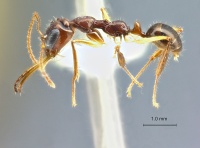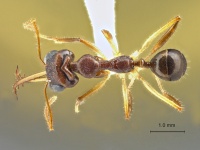Myrmoteras opalinum
| Myrmoteras opalinum | |
|---|---|

| |
| Scientific classification | |
| Kingdom: | Animalia |
| Phylum: | Arthropoda |
| Class: | Insecta |
| Order: | Hymenoptera |
| Family: | Formicidae |
| Subfamily: | Formicinae |
| Tribe: | Myrmoteratini |
| Genus: | Myrmoteras |
| Species: | M. opalinum |
| Binomial name | |
| Myrmoteras opalinum Bui, Eguchi & Yamane, 2013 | |
The two nests were found in soil, in a lowland forest in southern Thailand.
Identification
Bui, Eguchi and Yamane (2013) - This is a relatively small species, easily separated from other Indo-Chinese congeners by the milk- white colour of the coxae and femora of the mid- and hind legs, and the femora of all legs that are distinctly paler than the tibiae.
Keys including this Species
Distribution
Southern Thailand
Distribution based on Regional Taxon Lists
Oriental Region: Thailand (type locality).
Distribution based on AntMaps
Distribution based on AntWeb specimens
Check data from AntWeb
Countries Occupied
| Number of countries occupied by this species based on AntWiki Regional Taxon Lists. In general, fewer countries occupied indicates a narrower range, while more countries indicates a more widespread species. |

|
Estimated Abundance
| Relative abundance based on number of AntMaps records per species (this species within the purple bar). Fewer records (to the left) indicates a less abundant/encountered species while more records (to the right) indicates more abundant/encountered species. |

|
Biology
Castes
Nomenclature
The following information is derived from Barry Bolton's Online Catalogue of the Ants of the World.
- opalinum. Myrmoteras opalinum Bui, Eguchi & Yamane, 2013: 553, fig. 7 (w.) THAILAND.
Unless otherwise noted the text for the remainder of this section is reported from the publication that includes the original description.
Description
Worker
TL 3.5–4.0, HL 1.04–1.10 (1.06), HW 1.02–1.10 [1.08] (1.06), EL 0.65– 0.69 [0.67] (0.67), ML 1.31–1.37 (1.34), SL 1.21–1.30 [1.29] (1.27), PrW 0.63–0.67 (0.67), HfL 1.31–1.40 (1.37), CI 96–102 [98] (99), SI 118–120 (119). (Holotype and 5 paratype and non-type workers were measured.)
Head and mesosoma brown, slightly with reddish tinge; petiole and gaster dark brown; mid- and hind coxae and femora whitish yellow; femora of all legs distinctly paler than tibiae. Body with erect hairs; dorsum of head and pronotum and first gastral tergite with pubescence; lateral face of gastral tergite I and II with sparse pubescence (often abraded away). Clypeus and lower frons densely rugoso-punctate; area around antennal insertion finely rugoso-striate. Anteriormost part of pronotum with faint, transverse rugoso-punctatation, and remainder portion smooth or faintly and sparsely punctate; dorsum of mesonotum longitudinally or irregularly rugose; lateral face of mesonotum with several irregular rugae; mesopleuron, metapleuron and lateral face of propodeum smooth or faintly and sparsely punctured; dorsum of propodeum with faint, transverse rugoso-punctation. Frontal sulcus faint but reaching median ocellus (sometimes interrupted); anterior clypeal margin concave; mandible with 8 teeth that reduce in size from apical to basal teeth; two denticles present between first and second teeth; palp formula 6,4; orbital groove absent; scape distinctly shorter than funicular segments combined; funicular segments each longer than broad. Pronotum in lateral view with flat dorsal outline; mesonotum as long as high; propodeum in lateral view roundly convex posterodorsally. Petiolar node in lateral view with vertical anterior face and steep posterior slope; ventral outline of petiole beneath the node slightly sinuate.
Type Material
Holotype worker from southern Thailand, Surat Thani Province, Tai Rom Yen NP., nest in soil, 12 x 2011, leg. Sk. Yamane (TH11-SKY-045) THNMH. Paratypes: 9 workers from the same colony as holotype; 7 workers from the same locality, 12 x 2011, leg. Sk. Yamane (TH11-SKY-50) [[[ACEG|Katsuyuki Eguchi]], Musee d'Histoire Naturelle Genève, THNHM, SKY Collection, VNMN
Etymology
The specific name refers to the milk-white colour of the coxae and femora of the mid- and hind legs.
References
- Bui, T. V.; Eguchi, K.; Yamane, S. 2013. Revision of the ant genus Myrmoteras of the Indo-Chiese Peninsula (Hymenoptera: Formicidae: Formicinae). Zootaxa 3666:544-558.
- Khachonpisitsak, S., Yamane, S., Sriwichai, P., Jaitrong, W. 2020. An updated checklist of the ants of Thailand (Hymenoptera, Formicidae). ZooKeys 998, 1–182 (doi:10.3897/zookeys.998.54902).
References based on Global Ant Biodiversity Informatics
- Zryanin V. A. 2015. Important supplements to the ant fauna of Vietnam. Proceedings of the 10th ANeT International Conference, 23-26 October 2015, University of Kelaniya, Sri Lanka. 24.

